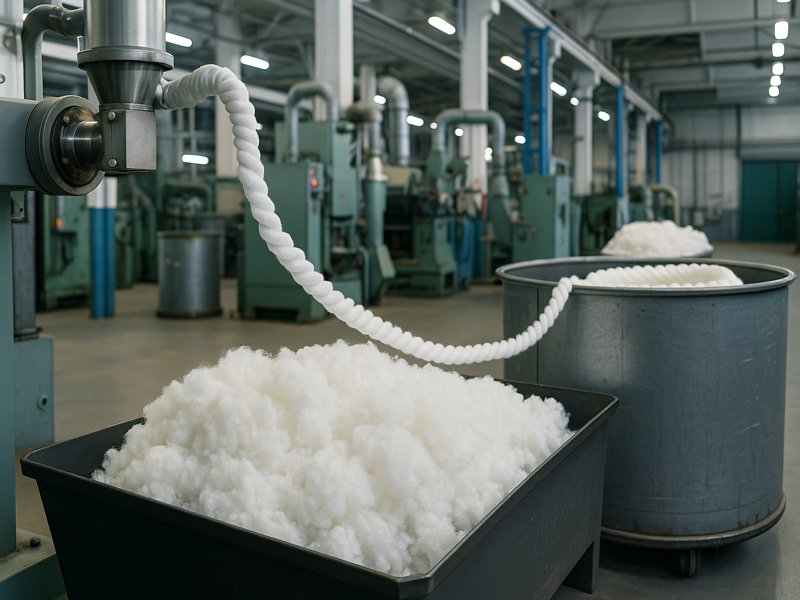Quality control (QC) is crucial in polystyrene fiber (PSF) production. As a professional PSF manufacturer, Boporea adheres to strict quality benchmarks, from raw material selection to final packaging inspection. For buyers, understanding these standards is crucial for assessing product quality, preventing downstream defects, and ensuring regulatory compliance.
Overview of Polyester Staple Fiber (PSF)
Polyester staple fiber is a short-length fiber made by cutting polyester filament fiber into defined lengths (commonly 32mm–102mm). It comes in two major types:
- Virgin PSF: Made from pure petrochemical feedstock.
- Recycled PSF (rPSF): Derived from post-consumer PET bottles or textile waste.
Applications include:
- Apparel and textiles (filling material, non-woven interlinings)
- Home furnishings (pillows, cushions, mattress pads)
- Automotive (seat stuffing, insulation)
- Construction (geo-textiles, acoustic panels)
Maintaining consistent quality in such diverse applications requires stringent control at every production stage.

Key Stages of Quality Control in PSF Production
Inspection of Raw Materials
The quality of the input materials determines the quality of PSF. Whether using virgin PTA and MEG or recycled PET flakes, raw material inspection is the foundation of QC.
Checks include:
- Purity and contamination (especially for rPSF)
- Moisture content
- Intrinsic viscosity (IV) for PET flakes
- Color (yellowness index)
- Metal detection
Suppliers often reject batches that fail to meet minimum IV or contain PVC, which can degrade PSF properties.
Spinning and Polymerization Controls
In virgin PSF, polymerization is followed by melt spinning. Maintaining temperature consistency and uniform melt flow is critical for fiber integrity.
Quality checks:
- Melt flow index (MFI)
- Polymer molecular weight
- Filtration system performance
- Spinneret cleanliness
For rPSF, the re-melting process requires more filtration and degassing to remove impurities, increasing QC importance.
Crimping and Cutting
Crimping introduces wave-like texture in the fiber, improving bulkiness, cohesion, and spinnability. Improper crimping affects feel, loft, and downstream processing.
Key parameters:
- Crimp per inch (CPI)
- Crimp stability
- Cut length accuracy (typically ±1mm tolerance)
Heat Setting and Finishing
After crimping, fibers undergo heat setting to stabilize the crimp structure and reduce shrinkage. Then, they are coated with finishes (e.g., antistatic agents, lubricants) to improve carding and blending.
Checks include:
- Finish add-on (%)
- Thermal shrinkage (typically <5%)
- Moisture regain (important for hygroscopic properties)
Bale Packing and Final Inspection
Fibers are compressed into bales for shipment. At this stage, weight, labeling, contamination, and fiber consistency are inspected.
Final quality checks:
- Bale weight uniformity
- Color variation
- Dust or foreign material detection
- Labeling and batch traceability
Modern production plants use barcode systems and digital QC logs for real-time tracking.

International Quality Standards for PSF
To ensure product quality and regulatory compliance, PSF manufacturers and buyers rely on internationally accepted testing methods and certifications. Key standards include:
A. ISO Standards
- ISO 2076: Standard terminology for man-made fibers
- ISO 1833: Quantitative chemical analysis for blended fibers
- ISO 13934: Tensile strength testing for fiber materials
- ISO 5079: Determination of breaking force and elongation of staple fibers
B. ASTM Standards
- ASTM D1577: Linear density of textile fibers
- ASTM D2256: Tensile properties of yarns and fibers
- ASTM D3822: Tensile properties of single textile fibers
These tests help verify critical mechanical properties like denier, tensile strength, elongation, and crimp recovery.
Critical Quality Parameters Buyers Should Monitor
Buyers—especially OEMs and textile manufacturers—should insist on technical datasheets and QC reports for every PSF shipment. Key specifications include:
| Parameter | Typical Range | Importance |
| Denier (dtex) | 1.2–15 dtex | Affects strength, softness, spinnability |
| Cut Length | 32mm, 38mm, 51mm, 64mm, 102mm | Must match spinning and blending equipment |
| Crimp per Inch (CPI) | 4–14 CPI | Affects bulkiness and processing behavior |
| Tenacity | ≥ 3.5 g/den (virgin), ≥ 2.5 g/den (rPSF) | Fiber strength |
| Elongation (%) | 20–50% | Flexibility and resilience |
| Shrinkage (%) | <5% after hot air at 180°C | Dimensional stability |
| Finish Add-on (%) | 0.1–1.0% | Processability and blending |
| Moisture Content (%) | 0.2–0.4% | Storage and static control |
| Yellowness Index | 2–30 (rPSF usually higher) | Color consistency and dyeing performance |
Third-Party Certifications Relevant to Quality Assurance
In addition to internal QC systems, manufacturers often hold third-party certifications to demonstrate quality and compliance.
A. OEKO-TEX® Standard 100
Ensures PSF is free from harmful substances, including formaldehyde, heavy metals, and allergenic dyes. Essential for apparel and home textiles.
B. Global Recycled Standard (GRS)
Certifies that rPSF contains genuine recycled content and adheres to environmental, chemical, and social criteria.
C. ISO 9001: Quality Management System
Verifies that a company has standardized process controls, documented procedures, and continuous improvement mechanisms in place.
D. REACH and RoHS Compliance
Mandatory for exports to the EU, especially in technical textiles, automotive, and furnishings. Limits hazardous substances in synthetic fibers.
Common Quality Defects in PSF and Their Causes
Even with strong controls, defects can arise in production. Here are common issues buyers should watch for:
| Defect | Description | Cause |
| Luster variation | Inconsistent shine or dullness | Uneven polymer melt or crimp setting |
| Color inconsistency | Uneven color in white/black/dyed fiber | Mixed feedstock (especially in rPSF) |
| Fiber dust or fly | Loose fibers break off during processing | Poor crimping or cutting |
| Stickiness | Fibers clump or stick in the carding process | Over-applied finish or moisture absorption |
| Low tensile strength | Fiber breaks during spinning | Poor polymerization or degraded PET |
| Poor dye uptake | Weak or uneven dyeing in blended yarns | Excessive thermal degradation or finishes |
Insisting on batch-level testing reports and retaining sample lots for every delivery is a best practice.
Quality Control in Recycled PSF (rPSF): Special Considerations
rPSF brings additional complexity due to variable feedstocks. Manufacturers must ensure:
- PET flake washing and drying (to prevent hydrolysis)
- Metal and PVC removal
- Consistent intrinsic viscosity
- Decontamination (especially for food-contact or apparel use)
Chemical recycling methods like depolymerization to BHET or DMT are gaining ground as they offer virgin-equivalent quality. However, buyers should still verify:
- Recycled content percentage (via GRS/RCS certificates)
- Physical property parity with virgin PSF
- Absence of contaminants and odor
What Buyers Should Ask Suppliers
To ensure quality assurance in PSF supply contracts, buyers should ask:
- Do you provide technical datasheets and third-party test reports for each lot?
- Can you share your ISO 9001, OEKO-TEX, or GRS certifications?
- How do you control crimp, cut length, and denier variation?
- What is your reject rate for internal QC?
- Do you perform lot-wise testing of recycled PET input (if applicable)?
- What is your policy on non-conforming materials?
- Can we perform a factory audit or video inspection?
- Are sample bales available for trial runs?
Final Inspection and Post-Shipment QC
Buyers should implement goods-inward quality checks, including:
- Random bale sampling
- Fiber strength and elongation tests
- Contaminant inspection (metal detection, black specks)
- Packaging integrity check
- Moisture and odor testing
Having clear rejection criteria in purchase agreements can protect against losses.
Buyers who understand the nuances of PSF quality—from technical fiber parameters to certification systems and testing standards—can make more informed purchasing decisions and minimize risks.

